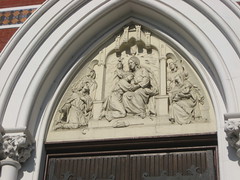From The Peopling of New York City
HOLIDAYS
In addition to Pulaski Day, which President Harry Truman decreed an official remembrance day in 1946, Polish American celebrations consist mainly of the prominent liturgical holidays such as Christmas and Easter. The traditional Christmas Eve dinner, called wigilia, begins when the first star of the evening appears. The dinner, which is served upon a white tablecloth under which some straw has been placed, consists of 12 meatless courses—one for each of the apostles. There is also one empty chair kept at the table for a stranger who might chance by. This vigil supper begins with the breaking of a wafer, the oplatek, and the exchange of good wishes; it moves on to such traditional fare as apple pancakes, fish, pierogi or a type of filled dumpling, potato salad, sauerkraut and nut or poppy seed torte for dessert. To insure good luck in the coming year one must taste all courses, and there must also be an even number of people at the table to ensure good health. The singing of carols follows the supper. In Poland, between Christmas Eve and the Epiphany (January 6, or "Three Kings") "caroling with the manger" takes place in which carolers bearing a manger visit neighbors and are rewarded with money or treats. In Poland, the Christmas season comes to a close with Candelmas day on February 2, when the candles are taken to church to be blessed. It is believed that these blessed candles will protect the home from sickness or bad fortune.
The Tuesday before Ash Wednesday is celebrated by much feasting. Poles traditionally fried pą1451czki (fruit-filled doughnuts) in order to use the sugar and fat in the house before the long fast of Lent. In the United States, especially in Polish communities, the day before Ash Wednesday has become popularized as Pączki Day; Poles and non-Poles alike wait in line at Polish bakeries for this pastry. Easter is an especially important holiday for Polish Americans. Originally an agrarian people, the Poles focussed on Easter as the time of rebirth and regeneration not only religiously, but for their fields as well. It marked the beginning of a farmer's year. Consequently, it is still celebrated with feasts which include meats and traditional cakes, butter molded into the shape of a lamb, and elaborately decorated eggs (pisanki), and a good deal of drinking and dancing.
PROVERBS
Polish proverbs display the undercurrents of the Polish nature, its belief in simple pragmatism and honesty, and a cynical distrust of human nature: When misfortune knocks at the door, friends are asleep; the mistakes of the doctor are covered by the earth; the rich man has only two holes in his nose, the same as the poor man; listen much and speak little; he whose coach is drawn by hope has poverty for a coachman; if God wills, even a cock will lay an egg; he who lends to a friend makes an enemy; no fish without bones; no woman without a temper; where there is fire, a wind will soon be blowing.
VISUAL ARTS
Korczak Ziolkowski (1909-1982), an assistant to Gutzon Borglum in the monumental Mount Rushmore project in South Dakota, continued that monumental style with a 500-foot by 640-foot statue of Chief Crazy Horse still being blasted out of solid rock in the Black Hills by his family.
FASHION
Traditional clothing is worn less and less by Polish Americans, but such celebrations as Pulaski Day on October 11 of each year witness upwards of 100,000 Polish Americans parading between 26th Street and 52nd Street in New York, many of them wearing traditional dress. For women this means a combination blouse and petticoat covered by a full, brightly colored or embroidered skirt, an apron, and a jacket or bodice, also gaily decorated. Headdress ranges from a simple kerchief to more elaborate affairs made of feathers, flowers, beads, and ribbons decorating stiffened linen. Men also wear headdresses, though usually not as ornate as the women's—felt or straw hats or caps. Trousers are often white with red stripes, tucked into the boots or worn with mountaineering moccasins typical to the Carpathians. Vests or jackets cover white embroidered shirts, and the favorite colors replicate the flag: red and white.
HOLLYWOOD
Hollywood has had its fair share of Polish-born men and women who have helped to shape that industry, including Harry and Jack Warner of Warner Bros. Entertainers and actors such as Sophie Tucker and Pola Negri also managed to hide their ethnic roots by changing their names. The pianist and performer Liberace (1919-1987), half-Polish and half-Italian, was born Władzie Valentino Liberace. More recently, the Polish-born Hollywood and international cinematographer Hubert Taczanowski has made outstanding contributions.
- Return to Cultural Contributions
- Return to Polish
